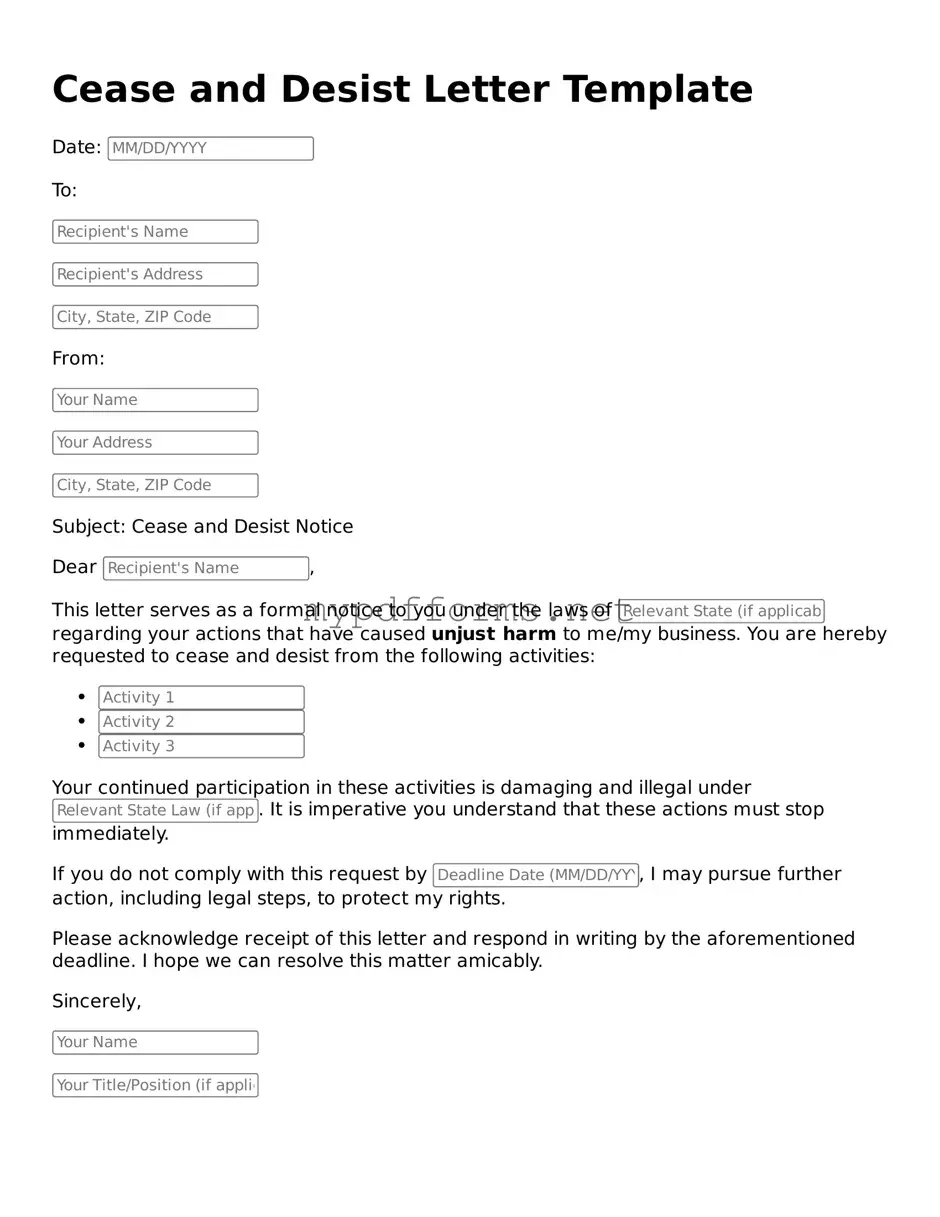A Demand Letter serves as a formal request for action or payment. Like a Cease and Desist Letter, it outlines specific grievances and requests that the recipient take corrective measures. Both documents aim to resolve disputes without escalating to litigation. A Demand Letter typically includes a deadline for response, urging the recipient to act quickly to avoid further legal consequences.
A Settlement Agreement is another document that shares similarities with a Cease and Desist Letter. While a Cease and Desist Letter demands that an action stop, a Settlement Agreement formalizes the terms under which parties resolve their disputes. Both documents require clear communication of the issues at hand, and they often include provisions to prevent future conflicts, ensuring that both parties understand their rights and obligations.
An Injunction is a court order that requires a party to do or refrain from doing specific acts. Similar to a Cease and Desist Letter, it seeks to prevent harmful actions. However, an Injunction is legally binding and issued by a judge, whereas a Cease and Desist Letter is a preliminary step that can lead to further legal action if the recipient fails to comply. Both documents aim to protect rights and interests, but an Injunction carries more weight in a legal context.
A Non-Disclosure Agreement (NDA) is designed to protect sensitive information. While it may not directly demand the cessation of an action, it prohibits the sharing of confidential information, similar to how a Cease and Desist Letter prohibits certain behaviors. Both documents serve to safeguard interests and establish clear boundaries regarding acceptable conduct, fostering trust between parties.
A Non-Compete Agreement restricts an individual from engaging in business activities that compete with a former employer. Like a Cease and Desist Letter, it seeks to prevent actions that could harm another party's business interests. Both documents are proactive measures aimed at protecting rights and preventing potential disputes, ensuring that parties understand the limitations placed upon them.
A Letter of Intent outlines the preliminary understanding between parties before a formal agreement is finalized. While it does not demand cessation of actions, it sets the stage for future agreements, similar to how a Cease and Desist Letter establishes expectations for behavior. Both documents help clarify intentions and can prevent misunderstandings that may lead to disputes down the line.
A Release of Liability document frees one party from claims or legal actions by another. While it does not directly demand that a party cease an action, it can be used in conjunction with a Cease and Desist Letter to mitigate future claims. Both documents aim to clarify responsibilities and protect parties from potential legal repercussions, fostering a clearer understanding of the relationship between them.
A Memorandum of Understanding (MOU) outlines an agreement between parties without creating legally binding obligations. Like a Cease and Desist Letter, an MOU can clarify expectations and responsibilities, helping to prevent disputes. Both documents serve as important communication tools, ensuring that all parties are on the same page regarding their intentions and actions.
A Letter of Complaint formally expresses dissatisfaction with a product or service. Similar to a Cease and Desist Letter, it communicates a need for action to rectify a situation. Both documents serve as a means of addressing grievances and can lead to resolution without further escalation. They emphasize the importance of clear communication in resolving conflicts effectively.
The California Motorcycle Bill of Sale form is a crucial document that serves as proof of the sale and transfer of ownership of a motorcycle. This form not only protects both the buyer and the seller but also ensures that all necessary information is documented for future reference. Understanding its importance can help facilitate a smooth transaction and avoid potential disputes. For more information, you can visit motorcyclebillofsale.com/free-california-motorcycle-bill-of-sale.
A Notice of Violation informs a party that they are in breach of specific rules or regulations. This document is akin to a Cease and Desist Letter in that it demands corrective action. Both serve as formal notifications that prompt the recipient to address the issue at hand, helping to maintain compliance and prevent further legal complications.
